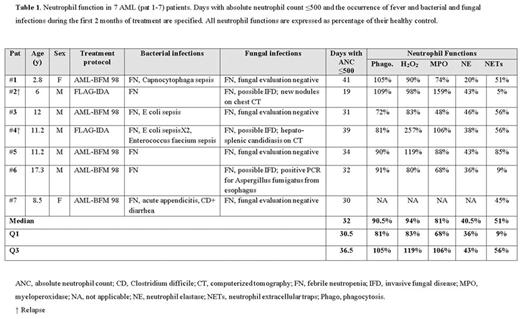Abstract
Background: Infections pose a considerable threat for children with acute lymphoblastic leukemia (ALL) and acute myeloid leukemia (AML) and although severe neutropenia is the most important predisposing factor, neutrophil dysfunction may contribute to this process. Neutrophil extracellular traps (NETs) bind and kill bacteria and fungi by providing a high local concentration of antimicrobial molecules. A crucial step in NET formation is the hydrogen peroxide-dependent translocation of neutrophil elastase (NE) from azurophilic granules to the nucleus. Myeloperoxidase (MPO) follows NE to the nucleus where both promote chromatin decondensation. Data on the production of NETs in leukemia patients are scant.
Patients and Methods: All consecutive male and female pediatric leukemia patients treated in our Pediatric Hemato-Oncology Department between 01/03/14-31/09/15 were initially recruited to this prospective study. Phagocytosis, hydrogen peroxide production, NE and MPO enzymatic activity and NETs production were studied at the end of induction and the occurrence of neutropenia, fever and infections during the first 2 months of intensive chemotherapy recorded. The study was approved by the local IRB. All parents signed an informed consent form.
Results: Of 22 consecutive male and female pediatric leukemia patients initially recruited, excluded were 1 AML patient with a subsequent diagnosis of shortened telomeres that could affect neutrophil function, 1 Philadelphia chromosome-positive ALL patient that received imatinib in combination with intensive chemotherapy and 3 AML patients that had partial results that did not include NETs. Therefore, the final study group (n=17) comprised 10 ALL patients (7 primary, 2 secondary and 1 relapsed) and 7 AML patients (5 primary and 2 relapsed). There were 10 males and 7 females with a median age [Q1, Q3] of 7.6 years [1.9 years and 11.2 years]. All patients entered complete remission after induction. On the day of examination, patients with AML had a higher median absolute neutrophil count than those with ALL (2800 vs 750 cells/μL) that approached statistical significance (P = .06). Nevertheless, NE activity and NETs were significantly lower among patients with AML than those with ALL (median [Q1, Q3] of 40.5% [36%, 43%] vs 90% [57%, 115%], P = .005 and 51% [9%, 56%] vs 93.5% [74%, 100%], P = .008, respectively), while there were no differences in the other neutrophil functions studied. Patients with AML had more episodes of febrile neutropenia (100% vs 40%, AML vs ALL, respectively, P = .011) and a trend for more invasive bacterial and fungal infection. Interestingly, there was no difference in the number of days with neutropenia (absolute neutrophil count ≤500) during the first 2 months of chemotherapy between the 2 groups [median [Q1, Q3] of 32 days [30.5, 36.5] in AML vs 30 days [25, 43] in ALL, P = 0.87) (Tables 1 and 2, Figure 1).
Discussion: We have shown for the first time that NE activity and NETs formation are significantly decreased after induction chemotherapy in pediatric AML but not in pediatric ALL. This phenomenon in AML might be related to immaturity of the NE in neutrophils released from a recovering bone marrow after induction or to down-regulation of NE activity by a yet unknown cellular factor and might contribute to an increased rate of infections among this vulnerable population. Further studies are needed to elucidate on this topic.
No relevant conflicts of interest to declare.
Author notes
Asterisk with author names denotes non-ASH members.




This feature is available to Subscribers Only
Sign In or Create an Account Close Modal